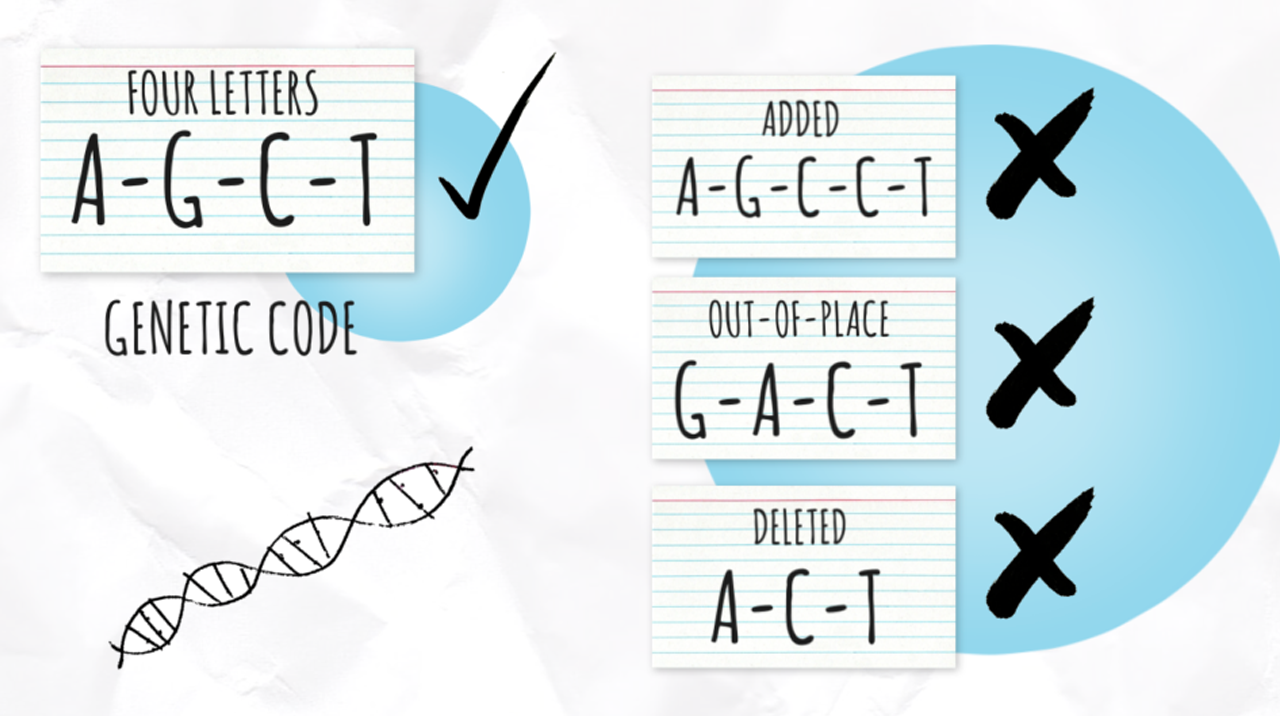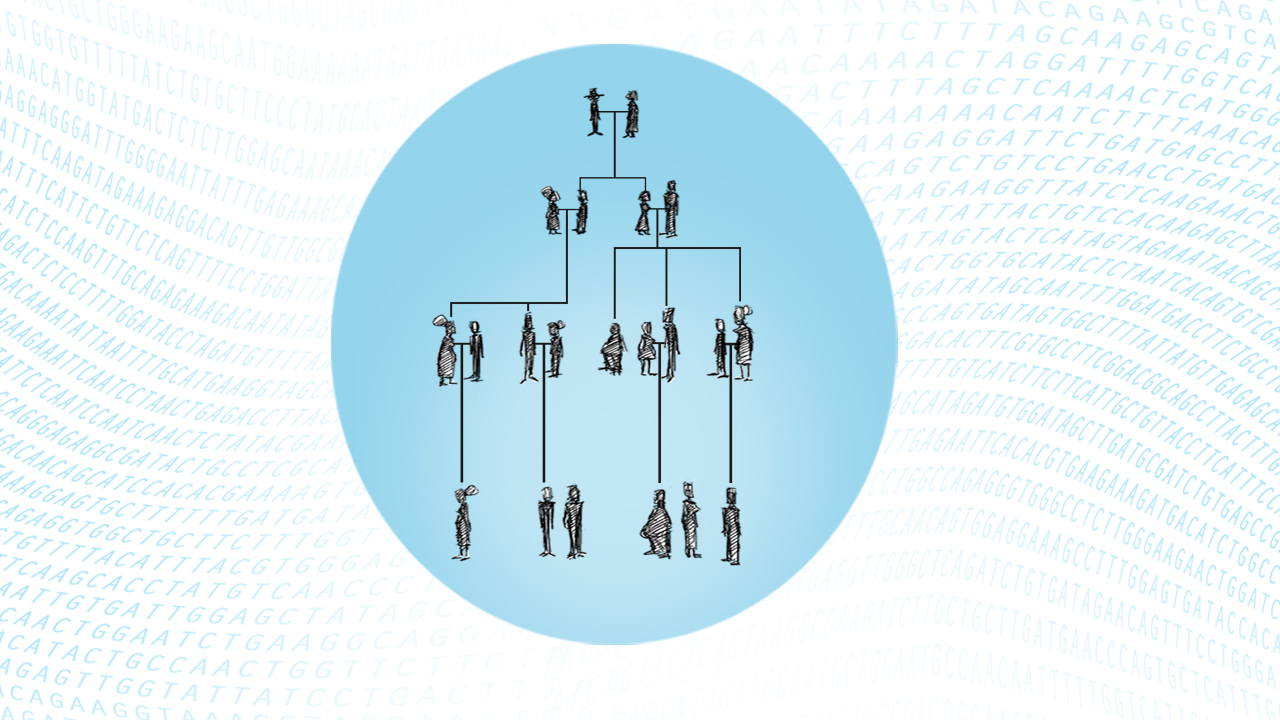Genetics 101

Just like sentences in a book, genes are made up of four letters of DNA: A, T, G, and C. These four letters create the genetic "code" (or instructions) that sends messages to our bodies that determine our unique traits (like eye color) and keep us healthy.
Our genetic code works very similarly: the letters of a gene have to be in a specific order to maintain our health. Just like with words, if a letter is added, out of place, or deleted, the message may not make sense and the gene's message may not be understood by the body. This is called a genetic change or alteration, and when an alteration can impact our health, it is called a mutation.
Watch this video!

Some genetic changes are harmless. These changes (or alterations) may be the causes of people having different eye color or different hair color. None of these differences impacts our health. However, if the genetic alteration is a mutation, it can be the cause of health problems such as an increased risk to develop cancer. When people have a mutation in a gene whose function is to protect the body from cancer, the gene may no longer work like it should. This may cause someone to have an increased chance to develop cancers, usually at younger ages than expected. These cancers are often part of what are called hereditary cancer syndromes. There is a whole specialty in medicine devoted to treating, preventing, and understanding of hereditary cancer syndromes.
You may be wondering about how gene mutations occur in a family. We are learning more and more about the causes of the gene mutations every day. It's not always clear why some people carry these and others do not. In families with hereditary cancer syndromes, which may be yours, many relatives may carry the same gene mutation, and have similar cancers develop at similar ages.
How do we find genetic alterations/mutations?
In the past, genetic testing laboratories have been able to find genetic mutations in families by studying the most likely genes, one at a time, through genetic testing. This often resulted in a costly and time-consuming process for the patient and healthcare provider. Multi-gene "panel" testing is now available, in which many genes associated with hereditary cancer syndromes are tested at once, to provide the patient and family the answer in a more timely and cost-efficient manner.
Multi-gene panel testing allows healthcare providers to better treat and manage their patient's health by helping them understand the underlying genetic cause of the cancers in a patient and/or family. The human body is a complex system and there is still so much to understand. As researchers and doctors continue to learn more about the human body, we will also learn more about how to create better treatments and cures for hereditary cancer syndromes.
Genetic testing is a type of medical test (usually a blood test) that identifies changes in chromosomes, genes, or proteins. The results of a genetic test can confirm or rule out a suspected genetic condition or help determine a person's chance of developing or passing on a genetic disorder.
There are two main types of genetic testing:
- If you have a cancer diagnosis, you may be most familiar with somatic or tumor testing. This genetic testing is done with a sample of tumor. The DNA in the tumor is studied to determine if different treatments may be better or worse for you. Your cancer doctor or team will be the best resource to discuss this type of genetic testing.
- The second type of genetic testing is called germline genetic testing and is done using a blood or saliva sample. The DNA in your blood cells is studied to see if there is a mutation that causes an increased risk to develop cancer. This genetic testing can be done on someone who has cancer or who does not have cancer. You may be seen by a genetic counselor or other healthcare provider to discuss genetic testing before it happens.
| Term | Definition |
|---|---|
| Genetic | A medical condition or a trait that is related to our genes |
| Hereditary | A medical condition caused by a change in our genes that is passed down in a family. Sometimes this happens for the first time in someone, and they can pass it on to their children. |
| Inherited | A medical condition or a trait that can be passed down from parent to child |
| Multifactorial | A medical condition or trait caused by a combination of genetics and other factors |
When we talk about genetics, some terms get used often and we want to clarify them here. All living things are made up of billions of tiny structures called cells. Cells are the basic building blocks that make up each of us. Each cell we have contains our genes, which are even smaller structures with instructions that tell our cells how to work. Genes tell our bodies how to grow and develop, including aspects of our health. We inherit and pass our traits (like our eye color or hair color) between generations through our genes. Genetic conditions are those that are related to our genes, at least in some part.
Changes in our genes, like mutations, can cause medical problems. Some medical problems are hereditary, meaning they are caused by a gene mutation (or mutations) that are inherited (or passed on) from a parent. Sometimes, a mutation might occur for the first time in someone, and be passed on to their children.
Other medical problems may be multifactorial. This means they are due to a combination of genetics and other factors, such as lifestyle and environmental factors (like radiation, chemicals, and others). Examples of multifactorial conditions include some forms of cancer, heart disease, diabetes, and cleft lip/palate.
Interestingly, a medical problem may be genetic but not hereditary. But by definition, all hereditary conditions are genetic.